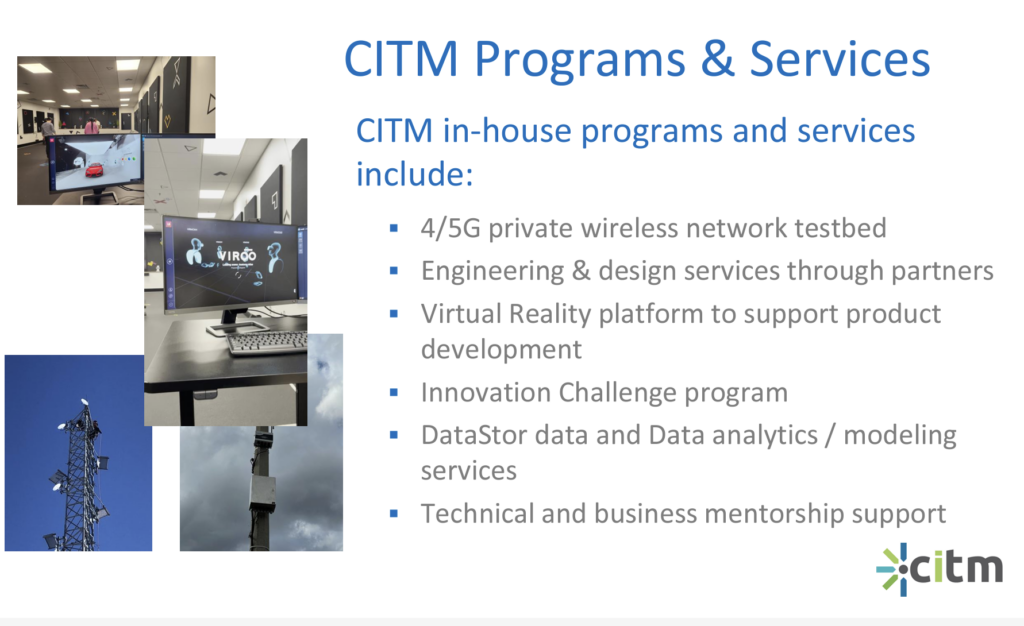Attention all public facility operators, municipal planners and regulators – robots are already being tested and used in airports, shopping malls, hospitals, zoos, and entertainment parks… what do you need to know? How can you be ready to leverage these technologies to address labour shortages? improve accessibility services? and improve services to your guests? In October 2024, Urban Robotics Foundation (URF) brought together a panel of experts to share highlights from some recent pilot projects.
Our panel included:
Vivek Burhanpurkar, CEO of Cyberworks Robotics, a client at CITM (and member of URF), that offers industrial tow tugs, industrial floor cleaners and personal mobility vehicles (wheelchair robots).
Matt Benson, partner at Seamless Ventures and Program Manager for FLITE (Ford Launchpad for Innovative Technologies and Entrepreneurship) – whose mandate is to test innovative technologies (including autonomous robotics) for airports.
The session was sponsored by the Centre for Integrated Transportation and Mobility (CITM) and was hosted by CITM Director, Richard Dunda.
How can public facilities use Wheelchair Robots, Cleaning and Cargo/Delivery Robots to improve operations?
Autonomous Mobile Robots (AMRs) and mobile equipment have not yet achieved the mass adoption that was predicted five years ago. This is because a number of “edge-case” problems have proven more difficult to solve than developers had predicted. These edge-cases cause AMRs to periodically fail and require operator interventions, sometimes several times per hour, which is not acceptable by commercial standards. According to their CEO, Cyberworks Robotics has solved these edge-cases for AMRs and industrial equipment applications such as floor scrubbing, material handling, indoor logistics and personal indoor transport, resulting in a 99% reduction in operator interventions in complex dynamic commercial environments like airports and grocery stores.

When used in public spaces around uninvolved ‘bystanders’, AMRs are considered “PMRs” – Public-area Mobile Robots. There are a growing number of use cases for PMRs as shown in the diagram below.
The focus of this webinar was the successful pilot project of Cyberworks’ ‘wheelchair’ robot – designed to transport people with mobility challenges – navigating through crowds in a live airport setting.
Some examples of the unique features of Cyberworks’ wheelchair robot include:
- No Visual Tags or Beacons required
- Elegant motion technology for smooth straight motion, eliminates motion sickness
- Switch on-the-fly between full self-driving, smart manual, and porter push modes
- Smartphone based tele-operation for remote assistance
- Map editor to designate no-go zones to avoid chair entering restricted areas
During the webinar, (18:30) Vivek talked about their self-driving technology and the ability of their devices to operate for over 100 hours without a single intervention or failure of any kind. This level of reliability is extremely encouraging for the expansion of the industry.
About FLITE
The Gerald R. Ford International Airport Authority, in collaboration with the Michigan Economic Development Corporation (MEDC), Seamless Ventures, Southwest Airlines® and the West Michigan Aviation Academy, has introduced the Ford Launchpad for Innovative Technologies and Entrepreneurship, or FLITE, which provides grants and pilot-testing opportunities to companies focused on bringing emerging air travel technology solutions to market. This is one of the first airport-based initiatives in the nation that provides funding to encourage the design and development of new products and services in a live airport environment.
During the webinar, (13:45) Matt talked about the preparation involved in designing the pilot project, the many stakeholders involved, and (26:00) the checklist of ~50 items that were evaluated during the pilot project, including a number of ‘surprise’ tests that his team interjected to evaluate the technology.

Panel Discussion & Audience Engagement
The interactive panel discussion included questions asked by Richard Dunda and URF’s Executive Director, Bern Grush. Additional questions came in from the audience and we ran out of time before being able to answer them all. Please subscribe to our e-newsletter and perhaps join URF as a member to keep up to date with all the developments related to testing and deploying PMRs in your facility/ies and public spaces!
About CITM

We are thankful to URF member and sponsor – the Centre for Integrated Transportation and Mobility (CITM) – for hosting today’s session. CITM is part of the Ontario Vehicle Innovation Network (OVIN), Ontario’s flagship initiative for the automotive and mobility sector.
Based in Hamilton, Ontario, Canada, CITM specializes in helping businesses take electrified, connected, and autonomous vehicle innovations from ideation to commercialization and scale-up. They provide a wide range of services and programs, all available at no cost to their clients thanks to their generous funders and partners.
CITM’s team of experts can assist innovators with finding product-market fit, developing their technology, and conducting pilot projects. They offer networking with industry leaders, business development and technical expertise, R&D resources and investors to help innovation reach its full potential.

Ready to start your own entrepreneurial journey? Apply to CITM to get started!





